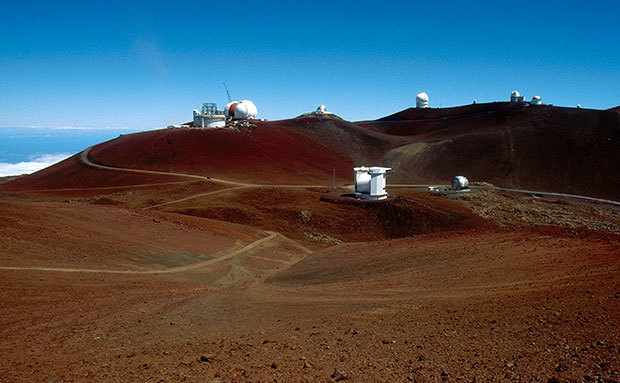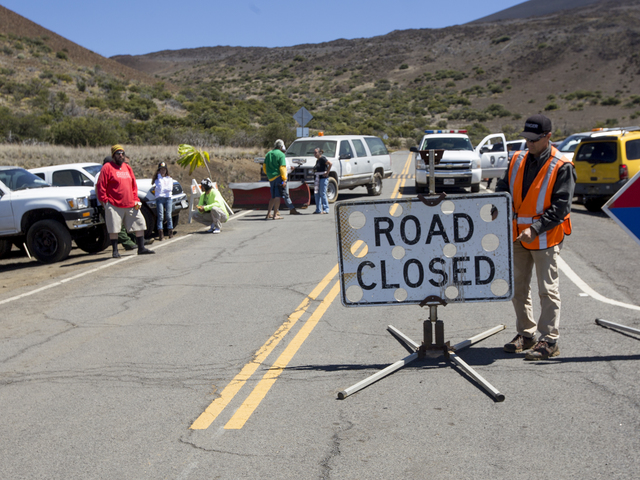The Office of Mauna Kea Management on Monday afternoon reopened the Mauna Kea Access Road, which was shut down last month following protests against the Thirty Meter Telescope.
The Office of Mauna Kea Management on Monday afternoon reopened the Mauna Kea Access Road, which was shut down last month following protests against the Thirty Meter Telescope.
Additionally, Gov. David Ige is planning to sign the new emergency rule that prohibits camping and restricts public access on the mountain, according to spokeswoman Cindy McMillan.
“The rules did not come over from (Department of Land and Natural Resources) today,” she said Monday. “We believe they will come over tomorrow.”
As for when the state plans to enforce the new rule is yet to be seen.
Joshua Wisch, a spokesman for state Attorney General Doug Chin, said that after being signed by Ige, the rule would be filed with the Office of the Lt. Governor. Only then would it go into effect, he said.
The road was reopened at 3 p.m. Monday, following remedial work and grading of the road that leads to the 13,796-foot summit of Mauna Kea. The access road was closed June 24 when TMT opponents blocked the road with stones during a protest.
Ige said in a statement that the state seeks to provide safe access to Mauna Kea summit by all lawful users.
“Unfortunately, the destructive actions of several individuals temporarily rendered the mountain road unsafe since June 24,” he said. “I am pleased (University of Hawaii) has reopened the road following its damage assessment and repairs.”
The Office of Mauna Kea Management operates under UH-Hilo.
As of Sunday, the permanent camp across the street from the Mauna Kea Visitors Information Station was still standing. Protesters have maintained a constant, 110-day presence on the mountain in opposition of the $1.4 billion telescope project.
The new emergency rule, passed by a 5-2 vote Friday by the state Land Board after hours of emotional testimony, aims to address what Chin called an “imminent peril” to public safety and natural resources resulting from the ongoing protests.
In addition to prohibiting certain camping gear, including sleeping bags, tents and stoves, the 120-day rule restricts being within a mile of Mauna Kea Access Road at night, between 10 p.m. and 4 a.m., unless in a moving vehicle.
In a statement following Friday’s decision, Henry Yang, chair of TMT International Observatory Board, said he appreciated the efforts of Chin, the Land Board and all who participated.
“More importantly, we are thankful to the people of Hawaii for giving us this opportunity,” Yang said. “We will do our utmost to be the best stewards of this precious resource that we are borrowing, to enhance the value of astronomy in the interest of humanity and the world.”
TMT declined a phone interview with the Tribune-Herald. It is unclear when the observatory is planning to resume construction, which has been at a standstill since March as a result of protests.
Asked when it plans to begin enforcing the new rules and whether it would give protesters time to dismantle their camp, a DLNR spokesman said the department does not discuss planned or possible law enforcement actions.
Vehicular access above the Hale Pohaku mid-level facilities will be by four-wheel drive vehicles only. Two-wheel drive vehicles will not be allowed past the end of the paved road at Hale Pohaku, according to officials.
UH spokesman Dan Meisenzahl said the four-wheel drive rule is temporary and that there is a still some loose material on the side of the road that makes it dangerous for two-way traffic for two-wheel drive vehicles.
The Visitor Information Station and its restroom facilities will remain closed.
Restrooms are available at the Mauna Kea Recreation Area and Pu‘uhuluhulu at the junction of Saddle Road and the Mauna Kea Summit Access Road. Portable toilets for the public are available on the summit.
Email Chris D’Angelo at cdangelo@hawaiitribune-herald.com.




